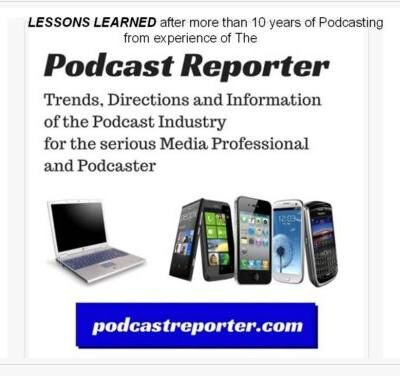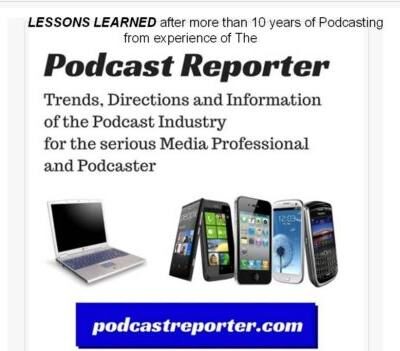Podcast: Play in new window | Download

In this episode of The Podcast Reporter, we reflect on some tips given by medium.com in an article titled “Top 5 tips for novice podcast editors.”
Now, this seemed interesting, because the task of editing the audio in podcasts (and the video for video podcasts — or screencasts that call themselves podcasts — is always a sore point with podcasters. This is because it can be a very time-consuming and arduous project for many who are not as technically competent as some of the original podcasters, or have very little patience or just want the fastest and easiest way to finalize an mp3 file for publishing. So the article is designed for those podcasters who are mainly doing editing for a client or for a fee.
The author, Tanner Campbell, cites these five tips for podcasters (which, in my opinion, are really designed for beginning or aspiring podcasters):
- Friction is public enemy #1 — and Tanner specifically highlights this with: “Friction should be defined as “any decision, action, or communication which unnecessarily forces a client to pay attention to you.”” This can also signify the impatience of customers who hire you to do the editing, as well as the desire to remain aloof until the customer gets frustrated with either delays or too much immediate communication. As a matter of fact, there are 2 quotes given for the emails you should be sending to the client.
- Learn to say “no,” to defend your standards and to value your time.
- There is no correct way to edit a podcast — regardless of what the client may expect or think or advise you to do (after all, YOU are the editor);
- Set expectations — like any good business, you should have a STATEMENT OF WORK that outlines the project, the jobs to be done, the tasks to be done, the time for each, etc. And if the client goes past the agreed-upon edit cycles (for me it was usually 2), then an additional charge must be spelled out in the contract and statement of work (e.g., twice the charge in your work breakdown schedule in your statement of work);
- Set boundaries (for ALL deliverables involved in the editing process);
Suggestions from experience in profitable editing
So, the factor of time can be a sore point for clients, who expect you to take every idea as it comes along and make changes. You should be aware of what Charlie “Tremendous” Jones said about the model known as Production to Perfection — especially for new edits just received for content that should have already been pronounced as “golden” or final. Otherwise, your podcast editing will NOT be profitable, and the client will never be satisfied and the editing project may drag on and on without end. You should avoid the saying from the client “I can’t describe it, but I’ll know when I see or hear it.”
Now, like any good business, you should have a STATEMENT OF WORK that outlines the project, the SCOPE of the work and the jobs to be done, the tasks to be done, the time for each, etc. And if the client goes past the agreed-upon edit cycles (for me it was usually 2), then an additional charge must be spelled out in the contract and statement of work (e.g., twice the charge in your project work breakdown schedule in your statement of work). This is a good way to set your boundaries, with the written signature of agreement from the client, so that there could be no misunderstanding of the boundaries and what the client can expect if he asks you to deviate from them.
As for this podcaster, I myself spend the most time in the preparation of both the CONTRACT and the STATEMENT OF WORK and SCOPE OF WORK for the client.
In one case, I actually did the editing and production of the final mp3 for the prospect BEFORE the SOW or the contract was signed. I did this so that he could see the quality of the audio and the finished mp3 (or, as he called it, the Productized deliverable). And I did not charge for this “proof of concept” delivered to him. After he was excited, then I submitted a detailed scope of work for the client, as well as the contract. And in the SOW and contract, I had referred to the proof of concept deliverables for the quality agreed to by the client.
I reviewed every detail with the client (and I did record our conversation about this agreement with him, so we could review the discussion later if there was a question about it that came up). Only then did the customer sign and initial both — and then the project was under way, with milestones and deadlines and dates for deliverables which were now set in stone (with any exceptions being spelled out in the contract). This prevented confusion or misunderstanding, and the recording just reinforced this.
And usually, the client was agreeable and happy and knew what he could expect and when. And this also gave me the opportunity to see if the client would become a GOOD client. If so, then additional discounts could be given (e.g., “customer value” discount) as well as some additional work being done as “added value” — as long as the customer recognized and agreed that this was above and beyond the call of duty, with no changes to other expectations. And this seemed to delight the client and cement the relationship.
So, what would happen if the client wanted to check out other editors and do some shopping around? I did welcome that and was patient to hear from the client if there was some new work coming. And surely enough, after an absence of receiving content (I presume that he had gone to another editor), the client returned and became a loyal client. I could only assume that he saw that the best customer service, value and quality came from myself as the editor, and not from anyone else with whom he dealt with just to save a few dollars.
I hope that you, as an editor, can review this article and see which of these practices make sense for your business. And I would suggest that the elements of any good project — the scope of work, the statement of work, the work breakdown schedule and the contract — are tools that you can master and include in your practice to become a successful podcast editor.
Thank you for your attention.
Copyright (c) 2020, Matrix Solutions Corporation and Tanner Campbell and medium.com. All rights reserved.
